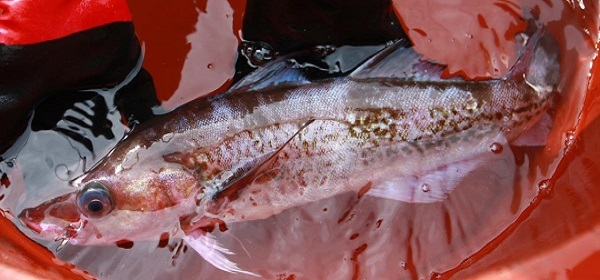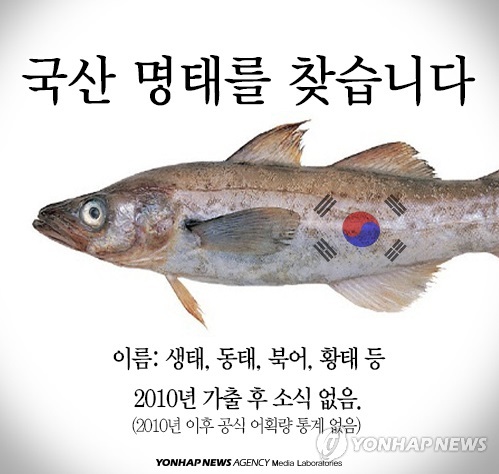South Korea’s wild pollack population, considered near-extinct since the turn of the millennium, may be making a comeback.
The Ministry of Oceans and Fisheries said Thursday that a wild pollack, locally called “myeongtae,” was caught in eastern waters near Uljin, North Gyeongsang Province. The fish, procured through a net installed 100 meters underwater, was 56 centimeters long, a tad smaller in size than its typical 61 centimeters. It was transported live to a research facility under the National Institute of Fisheries Science for further inspection.
 |
Wild pollack caught in waters off Uljin, North Gyeongsang Province (Yonhap) |
The government has been running a recovery project worth 24.8 billion won ($21.9 million) since 2014 to invigorate the South Korean pollack population. A crucial part of the project was releasing 1,000 fry, or juvenile fish, into the wild in the waters adjacent to the coastal city of Sokcho, Gangwon Province, last June.
The fry had labels attached to their dorsal fins to distinguish them from wild shoal. There were no signs of any labels on the fish caught Thursday.
Experts blame global warming along with ruthless overfishing for the decline of the pollack population in South Korea, which according to data released by the Japanese Government General of Korea, took up 14.9 percent of Korea’s entire seafood market in 1942. Currently, approximately 90 percent of pollack consumed in Korea is imported from either Russia or Japan.
 |
A poster designed to promote the search for Pollacks in South Korean waters. (Yonhap) |
Pollack is considered the James Bond of Korean seafood due to a wide spectrum of identities and names that follow both underwater and on the dinner tables. There are at least 28 different variations that derive from the Korean term “myeongtae,” based on the processing method, location and size of the fish.
Pollack caught fresh after spawning season are called “kkeoktae,” those caught in waters near Gangwon Province are dubbed “gangtae” and fry between the size of 20 and 25 centimeters are “nogari.”
Regarding its state of preservation, pollack dried under special conditions are labeled “hwangtae,” while freeze-dried ones are “dongtae” and the fully dried are “bookuh,” which is often used as a base ingredient for “hangover soup.”
The list goes on, as Koreans’ affection and longing for the fish -- and various dishes made from it -- has even bestowed it a fairly new moniker: “geumtae,” meaning “golden pollack” for its scarcity.
Folk rock star Kang San-ae took it to the next level and named a song after the fish in the early ‘90s. The number is a witty serenade with lyrics that praise the beauty of its versatility, taste and charming nicknames.
“You become my blood and flesh, too soft and delicious ... there is nothing to waste,” Kang sings.
Last September, a research facility under the Ministry of Oceans and Fisheries that focuses on the habitat of the East Sea successfully developed a technique that could farm breed the fish. The chief manager of the project, 52-year-old Dr. Byun Soon-gyu, has been called by his colleagues “Myungtae Daddy” for his contributions and dedication to the project.
In an interview with a local media outlet, Byun explained the project faced several difficulties due to the scarcity and sensitive nature of wild pollack. “The research started in the mid-2000s, but there was no progress due to its scarcity. Besides, problems continued even after we procured the subjects -- the fish would die from stress and wounds despite our efforts to provide the best environment.”
The project gained traction in 2015 following the procurement of a healthy female specimen that was able to provide 530,000 fertilized eggs. Now, the facility is a home to 500 fully matured pollack and 50,000 fry.
“We are expecting that households in Korea will finally be able to enjoy foods cooked from local pollack by 2020,” said the institute.
By Jung Min-kyung (
mkjung@heraldcorp.com)









